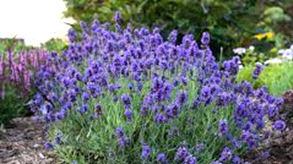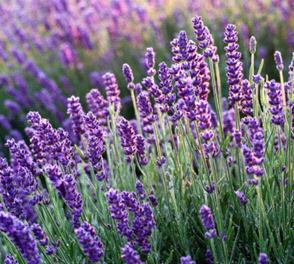Have you seen a field of lavender and smelled its fragrance in the air? It is a memory that can bring the sensations of summer to the coldest winter day. Lavender is a tough, drought tolerant plant and should grow well here but I, along with a number of other people have failed at this simple task. Until now.
Lavender originated in the Mediterranean area which is dry and rocky but warmer than our high desert. The French and Spanish Lavenders in particular do not tolerate temperatures much below freezing. The English Lavenders are said to tolerate temperatures down to zero but after two attempts with dead plants in the spring I had enough. Then came the hybrids -- they are game changers. They have more vigor so they are able to tolerate colder winters and other adverse conditions. After surviving for three winters and a wonderful bloom last summer I can say “YES” to Lavender.
The hybrid Lavenders are written: Lavandula x intermedia. Because they are hybrids, their plants are all patented. Some of the names are: Phenomenal, Exceptional, Grosso, Provence. There will be many more developed over time.
Lavender has been used for centuries in cooking and makes wonderful tea. Its oil can soothe sore muscles and improve mood as aromatherapy. Personal care products like soaps and lotions are very popular. Put a few branches in flower bouquets for beauty and fragrance.
If you are still concerned about the survival of Lavender in your location, take advantage of your “microclimates”. These are the warmer areas that develop on land as the winds flow around hills and valleys, houses and fences. An enclosed patio facing south will get more sun in the winter and keep the cold wind away from tender roots.
Lavender likes soil that is average to poor, and alkaline. Thankfully, that is exactly the kind of soil we have. The other thing lavender needs is good drainage. Even though the hybrid lavender is more tolerant of wet soil, you don’t want to set your plant in a location where water does not drain. Sandy soil is great. If you have clay, you already know how to add gravel and locate plants on an incline. Lavender also needs full sun to grow well. In our intense SW sun, some afternoon shade is ok.
Lavender plants can be one to three feet high and wide so space your plants accordingly. If you have a sunny patio, put plants in pots so you can enjoy their fragrance. Spring planting for lavender is best. Dig only as deep as the pot and twice as wide. Loosen the soil and place the root ball even with the soil line. Water to settle the soil and remove air pockets. Allow the soil to dry out between watering the first year. During the winter, keep it dry as lavender will rot if kept too wet. By the next year, water the lavender as you would your other drought tolerant plants.
A special event in Albuquerque every July is the Los Poblanos Lavender Festival. The fields of lavender are spectacular and there is music, food, and all kinds of lavender items on sale. Put it on your “Bucket List”.
Edith Iwan is a Cibola-McKinley County Master Gardener who lives and works in Thoreau. As a Master Gardener she assists the County Cooperative Extension Service in providing accurate, researchbased gardening information to county residents. If you have any gardening questions, please call the NMSU Cibola County Extension at 505-287-9266 or NMSU McKinley County Extension at 505-863-3432


